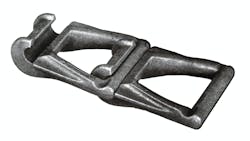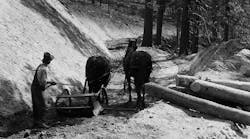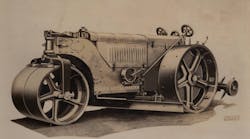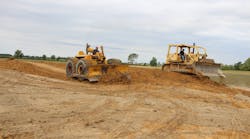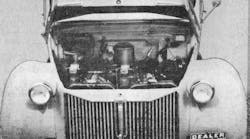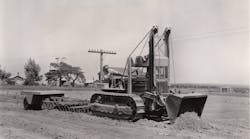As archivist for the Historical Construction Equipment Association, I find that one of the most fascinating aspects of the job is investigating the histories of the more than 3,000 manufacturers of construction, dredging, and surface-mining equipment (and related products) that are documented in HCEA’s archives. The history for many manufacturers is fairly straightforward; for others, however, origins and subsequent history can be rather novel.
Above: This detachable link chain, invented and patented by William Dana Ewart to enable drive chains to be repaired without having to discard the entire chain, gave rise to today’s extensive line of Link-Belt cranes and excavators. (Photo courtesy of Link-Belt Cranes.)
The majority of equipment manufacturing businesses were founded for that specific purpose—that is, to produce machinery. Some, however, don’t fit that mold. Consider, for example, the P&H brand.
Now a part of Komatsu Mining, P&H manufactured various types of equipment, including cranes and excavators, through most of the 20th century. But when the founders, Alonzo Pawling and Henry Harnischfeger, launched the firm in December 1884, their product was knitting machines—used to produce leggings for loggers. The firm quickly built an outstanding reputation, and soon other industries began requesting custom products. Entry into construction-crane manufacturing, for instance, was prompted by a special-order request in 1887 for overhead bridge cranes.
A couple of P&H’s clients also are examples of round-about entry into construction- machinery manufacture. For instance, Edward P. Allis, who had placed that first crane order, also purchased grain-roller mills from P&H for his flour-milling business. His firm eventually began manufacturing steam engines, and in 1901 merged with the Fraser & Chalmers Co. (founded in 1872 by Thomas Chalmers to manufacturer mining machinery, boilers, and pumps) to create Allis-Chalmers.
Allis-Chalmers produced a tremendous variety of industrial equipment, including a railroad shovel in 1905 as part of its Mining and Crushing Machinery department, but did not enter the construction equipment industry until purchasing the Monarch crawler tractor line in 1928 and grader manufacturer Ryan Mfg. Corp. in 1931.
The Chain Belt Co. started in 1891 by, as the name suggests, manufacturing belt chain, and had turned to P&H for conveyor belt links. Chain Belt diversified into conveyors and bucket elevators by 1900, and, shortly after the turn of the century, entered construction equipment manufacturing by introducing the Rex concrete mixer. The firm went on to produce concrete-production equipment, paving equipment, compactors, and stabilizers.
Today’s Link-Belt Cranes, a corporate member of the HCEA, has similar roots that go back even further—to the detachable-link chain patented in 1874 by William Dana Ewart. Like Chain Belt, Link-Belt entered the construction equipment industry via material-handling equipment, but where Chain Belt expanded into concrete equipment, Link-Belt introduced a wide-gauge locomotive crane in the 1890s, followed by construction cranes by 1922.
Some equipment manufacturers came about by sheer necessity. For example, when Robert G. LeTourneau, a land improvement contractor in Stockton, Calif., couldn’t find machinery to suit his needs from manufacturers of the day, he designed and built his own. LeTourneau’s entry into full-time manufacturing revolutionized both the earthmoving and heavy-equipment industries. More recently, pipeline contractor Mark “Ozzie” Osadchuck designed and built his own padding machine. His invention generated such interest that he sold his pipeline company’s assets at auction in June 1990 to focus full-time on the machine’s manufacture.
The Historical Construction Equipment Association (HCEA) is a 501(c)3 non-profit organization dedicated to preserving the history of the construction, dredging, and surface-mining equipment industries. With more than 4,000 members in 25 countries, HCEA’s activities include publication of a quarterly educational magazine, Equipment Echoes, from which this article is adapted; operation of the National Construction Equipment Museum and archives in Bowling Green, Ohio; and hosting an annual working exhibition of restored construction equipment. Individual membership within the United States and Canada is $35 for one year, $66.95 for two years, and $99.95 for three years; annual membership is $45 elsewhere. HCEA seeks to develop relationships in the equipment-manufacturing industry and offers a college scholarship for engineering and construction-management students. Information is available at www.hcea.net, by calling 419.352.5616 or e-mailing [email protected].
